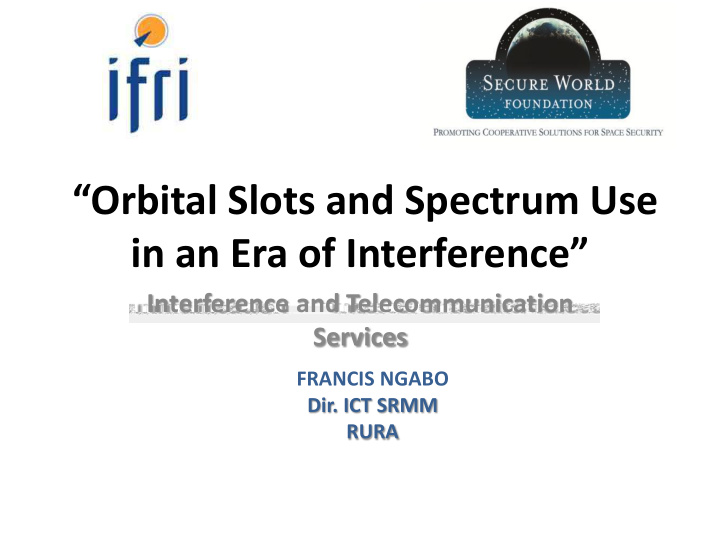



“Orbital Slots and Spectrum Use in an Era of Interference” Interference and Telecommunication Services FRANCIS NGABO Dir. ICT SRMM RURA
Presentation Outline • Interest in C Band • Sharing compatibility • Consideration for the future of C-Band • Conclusion 09-10-2014 ANNUAL SPACE CONFERENCE 2
Interest in C Band • Satellite services in C band are very popular because of their resistance to rain attenuation, hence popular for critical services requiring high reliability such as: – Banks backhaul link – Defense – Health care – Emergency etc Image from Satellite Spectrum Initiative http://satellite-spectrum-initiative.com/content.php?s_ID=27 09-10-2014 ANNUAL SPACE CONFERENCE 3
• Terrestrial services on the other hands have been looking for allocation in the C Band for IMT application since WRC-07. • Though WRC-07 did not allocate C Band globally, some administrations adopted IMT opt-in footnotes in the band 3.4- 3.6 MHz • WRC-15 A.I 1.1 seeks additional spectrum allocation for IMT on primary basis. • Frequency bands identified in the scope of A.I 1.1 includes C Band 09-10-2014 ANNUAL SPACE CONFERENCE 4
Sharing compatibility between Fixed Satellite Services (FSS) and IMT in C Band • Different studies have shown difficulties in sharing C Band with IMT. In Band sharing • Studies show that the required separation can go up to 100 Km, and in some cases up to 500 Km (in case of sharing between FSS and IMT micro cells). • Sharing of IMT-Advanced small-cell outdoor deployment scenarios the required separation go between 30 to 100 km. Adjacent Band Sharing • the required separation distance is to tens of km for IMT-Advanced macro-cell • Up to 5 km for IMT-Advanced small-cell outdoor deployments. 09-10-2014 ANNUAL SPACE CONFERENCE 5
• Sharing between IMT and the FSS in C-Band is feasible but prior regulatory measures need to be taken to restrict IMT power within the separation distance. • Additional measures like shielding or filtering can be used to reduce to reduce the separation distance. • Sharing should also take into consideration the protection of current services and protect future deployment of the incumbent services in C-Band. 09-10-2014 ANNUAL SPACE CONFERENCE 6
• The report of the WRC Conference Preparatory Meeting (CPM) on the sharing between IMT and FSS in C-Band further concludes that “ Deployment of IMT-Advanced would constrain future FSS earth stations from being deployed in the same area in the bands 3 400-4 200 MHz as shown by the studies.” 09-10-2014 ANNUAL SPACE CONFERENCE 7
Consideration for the future of C- Band • Agenda Item 1.1 of the WRC seeks additional spectrum allocation for IMT “1.1 to consider additional spectrum allocations to the mobile service on a primary basis and identification of additional frequency bands for International Mobile Telecommunications (IMT) and related regulatory provisions, to facilitate the development of terrestrial mobile broadband applications.” 09-10-2014 ANNUAL SPACE CONFERENCE 8
• Different methods have been provided in the report of Conference Preparatory Meeting (CPM). • In deciding which method to satisfy the Agenda Item 1.1 of WRC-15 for C-Band, key rationales should include: – The justification of additional frequencies for IMT in C- Band – The protection of the incumbent services – Consideration of future deployment of incumbent services in the geographical area of interest 09-10-2014 ANNUAL SPACE CONFERENCE 9
Conclusion • With the development of Broadband services, frequency Band with the capability of more reliability and coverage have experienced an increasing demand. • Frequency Spectrum being a scarce resource, services seeking additional allocation should clearly justify the need for additional resources in the band of interest. • In deciding whether to share C-Band between FSS and IMT, Administrations should first consider the protect of incumbent services. 09-10-2014 ANNUAL SPACE CONFERENCE 10
Thank you 09-10-2014 ANNUAL SPACE CONFERENCE 11
Recommend
More recommend